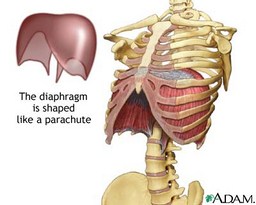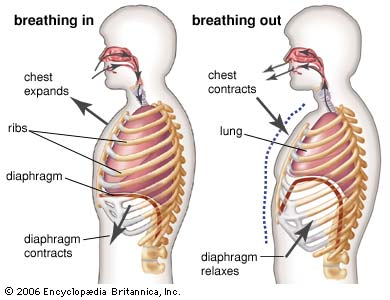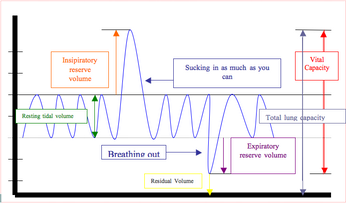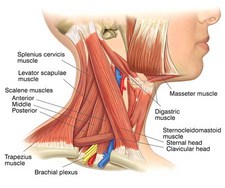
What kind of breather are you? Do you breathe from your abdomen or your chest? Don’t know? Take a look right now. Go in front of the mirror and take in a deep breath; observe how your body moves on inhalation. If your chest rises up, you’re a chest breather; if instead your belly protrudes like the Happy Buddha, then you’re an abdominal breather. I suspect that you, like most people, don’t want to project more gut than you have to, so probably you are a chest breather. Let me be the first toi commend you on keeping your gut in. But when it comes to breathing properly, abdominal breathing is best.
Abdominal breathing is actually the way our bodies are meant to breathe. It uses the diaphragm, a dome-shaped muscle that traverses the upper torso. When the diaphragm contracts, it pushes downward, protruding the belly and opening up the thoracic cavity (our chest cavity). As the cavity opens, so do the lungs, and air enters through a process called negative pressure. Essentially, the pressure on the inside of the lungs is less than that on the outside, so air travels down its pressure gradient from high to low. When we exhale, the diaphragm relaxes, the thorax contracts and carbon dioxide (CO2) is released, as we prepare to take in the next shot of oxygenated air on the incoming inhalation.
In my Los Angeles, Beverly Hills and West Hollywood sports chiropractic office I teach all my clients proper breathing techniques, because I know how essential breathing is to good health; in fact, it is essential to life. In this article, I am going to teach you how to break the chest breathing habit and revert back to abdominal breathing (aka—diaphragmatic breathing). Once you do, you will see your energy soar, as your oxygen levels will increase from taking in a fuller, more vibrant breath. Please watch the accompanying video—watch it again and again to get the process and rhythm of abdominal breathing down; to get it lodged into your wiring. It shouldn’t take long; you’ll only have to do the exercise for two weeks before it becomes a part of your regular breathing pattern again.

Remember, your body wants to abdominally breathe; it has simply forgotten how to do so.
Abdominal Breathing Exercises
To do this exercise, I recommend lying on your back, especially in the beginning. If you practice the way I recommend, you’ll be able to focus on the breathing itself. As you get better at it, you can practice while moving around; in other words, simulating real life.
So while lying on your back, start by simply pushing your belly out as far as you can, as if to pretend you have a beer belly; push it out completely. If you already have a beer belly, then just enjoy the magnitude to which you can currently protrude your belly by pushing your diaphragm down as far as it will go…and then some more. You will see that as you go along through this exercise, your ability to push the diaphragm muscle downward will increase. It’s like lifting weights, except in this case the muscle you are contracting is your respiratory workhorse.
..png)
%20[320x200]%20(1).png)
Next you want to connect the contraction to your breath. Do so by slowly breathing in as you contract (I know, you might think that inhalation should pull your belly in, but it is the opposite). Connecting the breath to the diaphragmatic contraction might be tricky at first, especially if you have been chest breathing for a long time. Very likely you are a shallow breather.
.jpeg) Chest breathers use only the upper portion of their lung fields; this means that a large portion of the lungs—middle and lower fields—aren’t being utilized. Not only does it lead to poor oxygenation of your body, but it causes rapid, shallow breathing, basically the type of breathing we do when we get excited.
Chest breathers use only the upper portion of their lung fields; this means that a large portion of the lungs—middle and lower fields—aren’t being utilized. Not only does it lead to poor oxygenation of your body, but it causes rapid, shallow breathing, basically the type of breathing we do when we get excited.
Now, yes, excited here could mean emotionally excited, but it also could mean under stress; or sexually excited for that matter, since all excitement can take our breath away, quite literally. Excitement also brings along neurochemical and hormonal changes—so breathing rapidly as a regular pattern can lead to metabolic disorder in several systems all the way down to the molecular level.
So you want make sure that your breath and the pushing out of your belly are completely synchronized. What I find is that many people will not breathe-in fully at first while practicing this exercise, because they push their belly out too fast. Or they simply protrude the belly quickly, and continue inhaling while holding the belly out. Wrong. You must take in the deepest breath you can, all the while pushing the belly out…slowly, to perfectly match the breath in duration. OK, good.
Next, make sure to hold your breath for a millisecond at the top of the arc on maximum inhalation, then release. On exhalation, just let the belly naturally drop down toward the floor (toward your back actually). You might have to help a little on the exhalation, as we all carry a bit more air in our lungs which can actually be exhaled. Do so lightly for this exercise. And then do the same procedure of holding your breath for a millisecond, at the bottom of the arc this time, before inhaling again and repeating the entire process.

Once you get the rhythm down, you can do repetitions. Place one hand on your abdomen, and one on your chest. Start the breathing exercise. One thing to keep in mind is that this is an exercise—it is not your current breathing pattern; so as a result, you may get winded. If you do, just stop, revert to your regular breathing, and go back to the exercise once you’ve caught your breath.
You’ll want to do repetitions for one minute only. If you do not have a clock nearby, it will be approximately 20 breaths. Do this exercise first thing in the morning, before you get out of bed; and do it again at night right before you fall asleep. If you do it this way, I promise you’ll have more energy in the morning, and you’ll have a deeper sleep at night, because you are getting more oxygen than you’ve probably had in a long time.
And don’t fret if you find this exercise boring or are uncertain of its power. You really only have to do it for two weeks, and your body should pick it up as its regular pattern. Let me say this again: you are meant to breathe diaphragmatically—that’s what the muscle is for. You will be amazed at how good you feel in just two short weeks if you stick with it; it’s a powerful process if you allow yourself to do it.
To get a better idea of how to breathe abdominally, watch the video below.
Abdominal Breathing: Step by Step
Here is the exercise broken down into parts:
.jpg) First, start by practicing pushing your belly out (diaphragm down)
First, start by practicing pushing your belly out (diaphragm down)- Pick up the rhythm by connecting your pushing to your breath (synchronize), and don’t forget to hold for a millisecond at the top and bottom of the arc (wave)
- For those who’ve got the breathing process down, start here: One hand on the abdomen, one on the chest
- Breathe in deeply, while pushing the belly out synchronously; hold at the top for a millisecond (the belly hand should rise before the chest hand)
- Release; let the breath out all the way; you might need to help, pushing lightly down at the end of exhalation; hold at the bottom for a millisecond.
- Breathe in and repeat: ~ 20 times.
You can also do this exercise as many times as you’d like during the day. You do not have to be lying down every time (just the two at the beginning and end of the day); in fact, doing it while you are up and about will teach your body how to breathe properly while moving—a very useful skill.
Abdominal Breathing and Neck Pain
 Abdominal breathing can also relieve neck pain by relaxing the accessory muscles of the neck and upper back which must continually contract during chest breathing. As I described earlier, the neck and upper back muscles, primarily the upper trapezius, scalene and sternocleidomastoid (SCM) muscles, must engage to raise the chest and open the thoracic cavity. Since these muscles have other functions—like various movements—engaging them repeatedly for a continuous process can make them fatigue (causing soreness), get tight, and develop trigger points (knots, in laymen’s terms). Think about this constant muscular engagement of the accessory muscles as a repetitive weight lifting exercise. How would any other muscle you regularly work out at the gym handle constant contraction?
Abdominal breathing can also relieve neck pain by relaxing the accessory muscles of the neck and upper back which must continually contract during chest breathing. As I described earlier, the neck and upper back muscles, primarily the upper trapezius, scalene and sternocleidomastoid (SCM) muscles, must engage to raise the chest and open the thoracic cavity. Since these muscles have other functions—like various movements—engaging them repeatedly for a continuous process can make them fatigue (causing soreness), get tight, and develop trigger points (knots, in laymen’s terms). Think about this constant muscular engagement of the accessory muscles as a repetitive weight lifting exercise. How would any other muscle you regularly work out at the gym handle constant contraction?
It is not that the accessory muscles have no role to play in the breathing function. They are called the accessory muscles precisely because they do engage in the breathing process when we need extra air—like during heavy exercise, asthma attacks, or even during the stress response. By helping the diaphragm, the accessory muscles ensure we get enough oxygen to power us through a challenging situation. However, they should not be working 24/7—and that’s exactly what they do in chest breathers.
By reverting back to diaphragmatic breathing, the accessory muscles have the opportunity to relax, decreasing soreness, stiffness, and trigger points. But most important, they will be ready to kick in when you need them most—during heightened stress—and thus will save you if you ever need a burst of energy.
So you can see how important it is to return to normal diaphragmatic breathing. Our breathing function is quite possibly the most important in the short-term of survival. Ask any emergency room physician and they’ll tell you that breathing problems get first attention. If you are not breathing properly, you could die. And if you are a chest breather, trust me when I say, you are not as healthy as you could and should be.
But once again, it is not hard to revert back to the normal diaphragmatic breathing you are meant to do. Do the abdominal breathing exercises for two weeks minimum, and I guarantee it will become your natural breathing process once again. You’ll see, just put in the work—the benefits are massive.
Once you start to breathe properly again, you’ll get more out of your workouts, you’ll sleep better, your pain will diminish, and best of all…you’ll look better. Say goodbye to pastiness and pallor, and say hello to vitally. You’ve got my word on it. If you need help with this exercise or any other pain problem, please contact my Los Angeles, Beverly Hills, and West Hollywood sports chiropractic office today.
Breathe well.

